
Anne Catherine Emmerich, CRV was a Roman Catholic Augustinian canoness of the Congregation of Windesheim. During her lifetime, she was a purported mystic, Marian visionary, ecstatic and stigmatist.
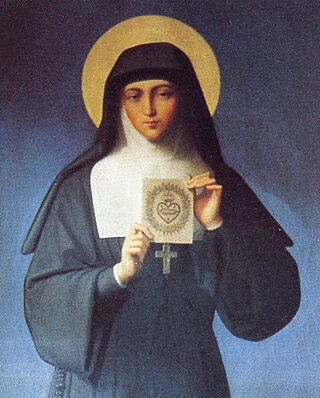
Margaret Mary Alacoque, VHM was a French Visitation nun and mystic who promoted devotion to the Sacred Heart of Jesus in its modern form.

Johannes Tauler OP was a German mystic, a Catholic priest and a theologian. A disciple of Meister Eckhart, he belonged to the Dominican order. Tauler was known as one of the most important Rhineland mystics. He promoted a certain neo-platonist dimension in the Dominican spirituality of his time.

Henry Suso, OP was a German Dominican friar and the most popular vernacular writer of the fourteenth century. Suso is thought to have been born on 21 March 1295. An important author in both Latin and Middle High German, he is also notable for defending Meister Eckhart's legacy after Eckhart was posthumously condemned for heresy in 1329. He died in Ulm on 25 January 1366, and was beatified by the Catholic Church in 1831.
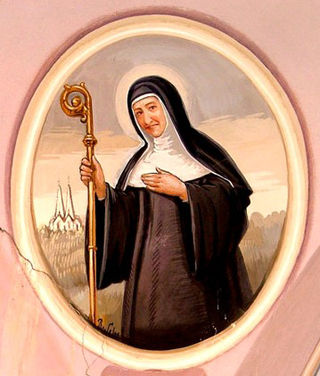
Mechtilde of Hackeborn, OSB, also known as Mechtilde of Helfta, was a Saxon Christian saint and a Benedictine nun. She was famous for her musical talents, gifted with a beautiful voice. At the age of 50, Mechtilde went through a grave spiritual crisis, as well as physical suffering. In the modern Benedictine calendar, her feast is celebrated on the anniversary of her death, November 19. She died in the convent of Helfta, near Eisleben.
Christina Ebner, was a German Dominican nun, writer and mystic.

Claude La Colombière was a French Jesuit priest best known as the confessor of Margaret Mary Alacoque. He is venerated as a saint in the Catholic Church.
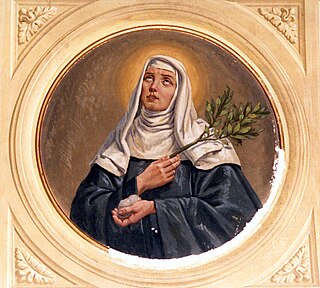
Veronica of Milan was an Italian nun in the Augustinian Order. She was reputed to have received frequent visions of the Virgin Mary, and her local cultus was confirmed by Pope Leo X in 1517.
Henry of Nördlingen was a German Catholic priest from Bavaria, who lived in the 14th century, his date of death being unknown. He was the spiritual adviser of Margaretha Ebner, the mystic nun of Medingen.

Medingen Abbey or Medingen Convent is a former Cistercian nunnery. Today it is a residence for women of the Protestant Lutheran faith near the Lower Saxon town of Bad Bevensen and is supervised by the Monastic Chamber of Hanover. The current director of the abbey (Äbtissin) is the art historian Dr Kristin Püttmann.
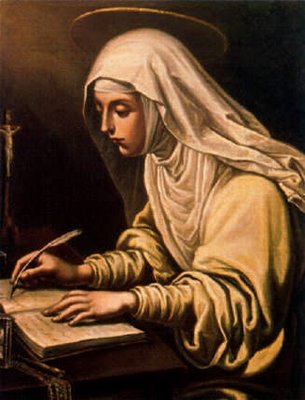
Catherine de' Ricci, OP, was an Italian Catholic nun in the Third Order of St. Dominic. She is believed to have had miraculous visions and corporeal encounters with Jesus Christ. She is also said to have spontaneously bled with the wounds of the crucified Christ. She is venerated for her mystic visions and is venerated as a saint by the Catholic Church.

Mary of the Divine Heart, born Maria Droste zu Vischering, was a German noblewoman and religious sister of the Catholic Congregation of Our Lady of Charity of the Good Shepherd. She is best known for having influenced Pope Leo XIII to consecrate the world to the Sacred Heart of Jesus. Pope Leo XIII called the solemn consecration "the greatest act of my pontificate".

Maria Faustyna Kowalska, OLM, also known as Maria Faustyna Kowalska of the Blessed Sacrament, was a Polish Catholic religious sister and mystic. Faustyna, popularly spelled "Faustina", had apparitions of Jesus Christ which inspired the Catholic devotion to the Divine Mercy, therefore she is sometimes called the "secretary" of Divine Mercy.

Agnes of Jesus, OP was a French Catholic nun of the Dominican Order. She was prioress of her monastery at Langeac, and is venerated in the Catholic Church, having been beatified by Pope John Paul II on 20 November 1994.

St.Theresa Church is a Catholic church under the jurisdiction of the Archdiocese of Madras-Mylapore (Chennai-Mylai) in Tamil Nadu, India, in Sembiam division of Perambur, Chennai. Approximately 900 families have the membership in this Catholic parish. Many people from various parts of Chennai make pilgrimage to this church for the devotion of Infant Jesus.

Maria Repetto was an Italian Roman Catholic professed religious from the Sisters of Our Lady of Refuge in Mount Calvary. Repetto was an ardent devotee of Saint Joseph and promoted devotion to him while distributing medals and images of him to those who visited the convent she was at; she also distinguished herself as an able carer for cholera victims on two occasions of epidemic.
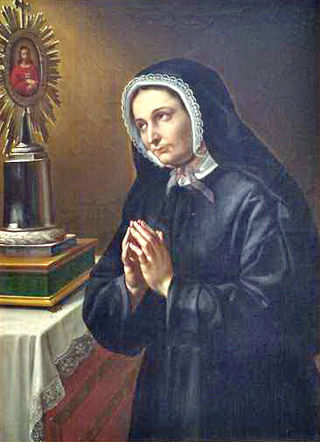
Elisabetta Canori Mora was an Italian member of the Third Order of the Most Holy Trinity. Mora married an abrasive husband who remained unfaithful and abusive to her but at the time of her death secured his repentance, and he became a priest. Mora had a range of spiritual experiences in which she heard the voice of God and visions of the Madonna and other saints while also experiencing religious ecstasies during her life.

Gertrude Prosperi was an Italian Benedictine. Prosperi assumed the religious name Maria Luisa Angelica and finally served as the abbess of her convent for an extended period of time until her death.
Jacomijne Costers was a nun and author whose vision of the afterlife, shown during a near-death experience, was written down in Visioen en exempel.
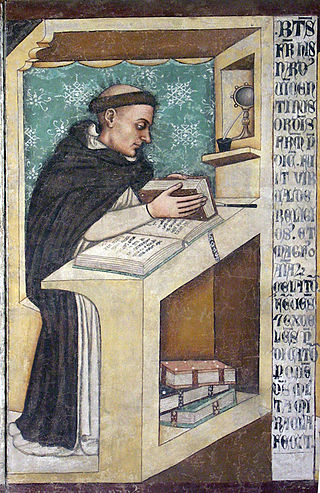
Isnardo da Chiampo, OP was an Italian Catholic priest and professed member in the Order of Preachers.


















